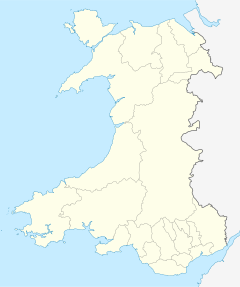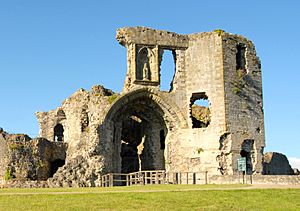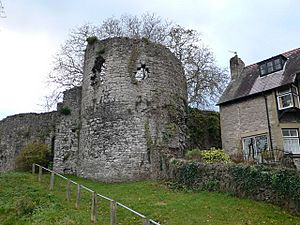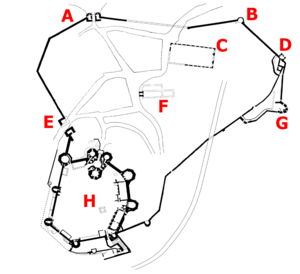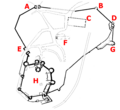Denbigh Castle and town walls facts for kids
Quick facts for kids Denbigh Castle and town walls |
|
|---|---|
| Castell Dinbych a waliau tref | |
| Denbigh, Wales | |
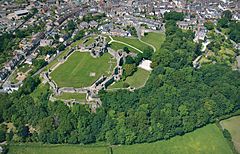
Aerial view of the castle and town walls
|
|
| Coordinates | 53°10′50″N 3°25′15″W / 53.1806°N 3.4207°W |
| Site information | |
| Owner | Cadw |
| Condition | Ruined |
| Site history | |
| In use | Open to public |
| Events | Welsh Wars Madog ap Llywelyn revolt Glyndŵr Rising Wars of the Roses English Civil War |
|
Listed Building – Grade I
|
|
Denbigh Castle and its town walls (called Castell Dinbych a waliau tref in Welsh) are old fortifications in Denbigh, Wales. They were built after King Edward I took control of Wales in 1282. The King gave the land to Henry de Lacy, the Earl of Lincoln. Henry started building a new walled town with a strong castle to protect it. He also created deer parks for hunting.
The castle and walls were not finished when the Welsh, led by Madog ap Llywelyn, briefly took the castle in 1294. Work continued, but the castle was still not fully complete when Henry died in 1311. Over the years, the castle had many owners. The walled town became less popular, and a larger settlement grew outside its walls.
In 1400, during the Glyndŵr Rising (a Welsh rebellion), the walled town was attacked. But the castle stayed safe. Later, during the Wars of the Roses, Denbigh was attacked again. The old walled town was mostly left empty after this.
During the English Civil War, Denbigh was held by the King's supporters (Royalists). But in 1646, Parliament's army took it after a long siege. In 1659, Royalist soldiers briefly took the castle back. After this, General George Monck ordered parts of the castle to be destroyed so it could not be used for war again.
Over time, the castle and old town became more ruined. In the mid-1800s, a local committee started to look after the ruins and repair them. In 1914, the government took over. Today, Cadw, a Welsh heritage group, cares for Denbigh Castle and its walls. They are open for visitors to explore.
The castle has a unique main entrance with three octagonal towers. It was considered a very advanced gatehouse for its time. Eight other towers protect the rest of the castle walls. The castle connects to the town walls, which are still mostly standing. These walls stretch for about 1,100 meters (3,600 feet) around the old town.
| Top - 0-9 A B C D E F G H I J K L M N O P Q R S T U V W X Y Z |
History of Denbigh Castle and Town Walls
Building the Castle: 13th Century
Denbigh Castle was built in an area called Perfeddwlad. This land was important for farming and had a royal home for Welsh princes. It was also a key location near the Welsh border, so it was often fought over.
In 1277, the Welsh prince Dafydd ap Gruffydd was given Perfeddwlad by King Edward I. Dafydd rebuilt the existing home, making it a strong castle. The Welsh called the area Dinbych, meaning "little fortress."
In 1282, Dafydd and his brother, Prince Llywelyn ap Gruffudd, rebelled against King Edward. Edward invaded North Wales with a huge army. After a month-long siege, Dinbych fell to Edward's forces in October 1282.
King Edward then created a new area called Denbigh. He gave this land to Henry de Lacy, the Earl of Lincoln. Edward and Henry planned to build a new castle on the site of the old Welsh home. This castle would help control the area.
Henry de Lacy used local workers and possibly men from England to build the castle. The western and southern parts of the castle and the new town walls were built first. This was to protect the workers. By 1285, Henry gave the new town its first charter, which was like a set of rules for the town.
The castle and town were part of a larger area controlled by Henry. He also created three deer parks around the castle.
The town walls enclosed an area of about 9.5 acres (3.8 hectares). In 1285, 63 burgesses (townsfolk) lived there. Each promised to provide an armed man to help protect the town. Most of these townsfolk were English. However, people soon started to move outside the walls. This was because there was limited space and not enough water inside the walled area. Within 50 years, a much larger settlement grew outside the walls.
The building of Denbigh Castle was not finished by September 1294. That's when a Welsh revolt, led by Madog ap Llywelyn, broke out. Welsh forces took the castle, and it wasn't recaptured until December. Work on the castle continued, but it was still not fully completed. This might have been because Henry's oldest son died in an accident at the castle.
Changes Over Time: 14th to 16th Centuries
When Henry de Lacy died in 1311, his daughter, Alice, inherited Denbigh Castle. Alice was married to Thomas, the Earl of Lancaster. The castle continued to be developed until Thomas was executed in 1322.
The next few years were unstable. The castle passed between several owners, including Hugh Despenser the Younger and Roger Mortimer, 1st Earl of March. Work on the castle and town walls continued during this time.
The Mortimer family took control of the area again in 1355. They repaired the castle's stone and wood over the next 50 years.
In 1400, Owain Glyndŵr led a major Welsh rebellion. His forces raided the town of Denbigh. However, the castle remained safe. Edmund Mortimer owned the castle then, but he was only eight years old. King Henry IV put Henry Percy in charge of Denbigh. Even when Percy joined the rebels in 1403, Denbigh Castle stayed loyal to the King until the rebellion ended in 1407.
Edmund Mortimer held the castle until he died in 1425 without children. Ownership then passed to Richard, the Duke of York.
During the Wars of the Roses, Denbigh was fought over by the Lancastrian and Yorkist families. Jasper Tudor, a Lancastrian supporter, was made constable of the castle in 1457. But the castle remained in Yorkist hands. After a Lancastrian victory, Jasper finally took the castle in 1460. The war then turned in favor of the Yorkists. The castle was recaptured by Sir Richard Herbert in late 1461.
Jasper Tudor returned to Denbigh in 1468. He couldn't take the castle, but he burned the inside of the walled town. This attack caused many people to leave the walled town and move to the newer areas outside. By the late 1500s, the inner area was mostly empty. It became part of the castle's outer defenses. The Burgess Gate in the town walls even became the town jail.
By 1530, much of the castle was falling apart. But six years later, it became the center for running the new county of Denbighshire. The great gatehouse and nearby towers were used as a courthouse and prison. The rest of the castle was in ruins by 1561.
Robert Dudley was given control of the castle in 1563. He built a large church in the walled town and made some small repairs to the castle. But not much other work was done before he died in 1588.
The English Civil War and Beyond: 17th Century
When the English Civil War began in 1642, Colonel William Salesbury held Denbigh Castle for King Charles I (the Royalists). The castle had a garrison of 500 men. Salesbury paid for work to make the castle stronger.
The war started to go against the Royalists. King Charles I stayed at Denbigh for three days in September 1645 while retreating from a battle. The next month, a Royalist army gathered near Denbigh. They planned to march to Chester to help forces there. But they were attacked and defeated by Sir Thomas Mytton's forces. Some Royalist soldiers retreated into the castle. Mytton took the outer parts of Denbigh but couldn't get into the walled town or the castle.
Mytton returned the next year with more equipment. In April 1646, he began a close siege of the castle and walled town. He set up earthwork bastions (strong points) for his guns. The Goblin Tower along the town walls, which held the garrison's main well, was heavily attacked. Mytton also placed more guns on a nearby hill to attack the south-western side of the walls.
Salesbury's position seemed hopeless. He only had one artillery piece and no Royalist help was coming. But he held on, saying he had promised the King he wouldn't surrender. Finally, King Charles I sent Salesbury a message, ordering him to give up Denbigh. After talks, Salesbury agreed to surrender on good terms on October 26.
After Salesbury left, Parliament put a small garrison in the castle. It was used as a prison for political prisoners. In 1648, Royalists tried to break into the castle to free the prisoners, but they failed.
In 1659, Sir George Booth led an uprising against the government. A group of Royalist soldiers took Denbigh Castle in August and captured the garrison. But after Booth's defeat a few weeks later, the rebels surrendered. The government took back the castle.
General George Monck then ordered the castle to be slighted, meaning parts of it were destroyed so it couldn't be used for war again. Parts of the walls and two towers were demolished over six weeks. The castle continued to fall into ruin. Its stones were even used to build houses in the town.
Denbigh Castle Today: 18th to 21st Centuries
Denbigh Castle remained in ruins for a long time. A new grammar school was built in the walled town in 1726. A bowling green was also created around 1769. Castle House, a large private home, was built using stone from the castle ruins.
In the mid-1800s, the walled town was still mostly empty. There were only a few rows of cottages. The western tower of the Burgess Gate was being used as a private house.
Around the mid-1800s, the town created a "Castle Committee" to look after the ruins. The government gave the committee control of the castle. In 1879, they lent them £300 to help with repairs. The government also took back control of the Burgess Gate and did conservation work.
In 1914, the central government's Office of Works took over responsibility for the site. In the late 1950s, the Ministry of Works bought and demolished later buildings along the walls. This was to clear the area for research and visitors.
Today, Cadw, the Welsh heritage agency, maintains Denbigh Castle and its town walls. The castle is open to visitors. In the mid-2010s, Cadw invested £600,000 in the castle and walls. This money helped build a new visitors' center. The site is protected by UK law as a scheduled ancient monument and the castle is a grade I listed building.
What Denbigh Castle Looks Like
The Castle's Design

Denbigh Castle sits on a high, rocky hill above the Clywd valley. The walled town is just below it to the north. The castle has a large gatehouse, with a curtain wall and mural towers around an inner area. It is about 350 feet (107 meters) by 260 feet (79 meters) across. Historian John Goodall calls it "one of the outstanding architectural creations of the Welsh conquest."
The Great Gatehouse has three octagonal towers forming a triangle around a central octagonal hall. It is protected by a barbican (an outer defense). The gatehouse was built with decorative bands of different colored stone. This was meant to show King Edward I's royal power. A statue, probably of Edward II, was above the main entrance. The gatehouse was defended by a 30-foot (9-meter) wide ditch, a drawbridge, murder holes (holes to drop things on attackers), and a portcullis (a heavy gate that drops down).
The three towers of the gatehouse have names: the Porter's Lodge and Prison towers face outwards. The Badnes Tower is at the back. Goodall believes it is "the most architecturally sophisticated gatehouse of the thirteenth century."
To the east of the gatehouse was the Queen's Chapel, which is now destroyed. The castle well is over 50 feet (15 meters) deep. The hexagonal, three-story Great Kitchen Tower and the White Chamber Tower (which was destroyed after the English Civil War) are next to the foundations of the Great Hall.
Further south is the Pitcher House Tower, likely used to store water. The Green Chambers are named for their green stone. These chambers have basements for storing meat and wine. The upper floors once had very fancy rooms.
At the southern end of the castle, the Postern Tower connects the castle to one end of the town walls. The Upper Gate and Postern Gate formed a back entrance to the castle. They were protected by another barbican, drawbridges, and a steep path.
A mantlet (a protective layer) of defensive terraces and walls surrounds the south and east sides of the castle. This prevented enemies from digging under the walls. This side of the castle was protected by the Treasure House Tower, the Tower-next-Treasure House, the Bishop's Tower (which had a secret exit), and the octagonal Red Tower. The Red Tower is named after the red sandstone used to build it. It connected to the other end of the town wall circuit. Stables, a blacksmith's workshop, and storehouses once stood inside the south-western corner of the castle.
The Town Walls
The town walls stretch for about 1,100 meters (3,600 feet) from the north edge of the castle to its southeastern tip. Most of them are still standing. The walls were built in the 13th century. They originally had four towers. Two gatehouses and defenses along the eastern side were added in the 14th century.
Only the foundations of the Exchequer Gate remain on the western side. This gatehouse would have had two round towers. It also had a rectangular glacis base, which is a sloping bank to prevent enemies from digging under it. The walls between the Exchequer and Burgess Gate are still complete.
The Burgess Gate has two round towers protecting a vaulted passage. It also has a distinctive glacis base. The gatehouse is built from white limestone and yellow sandstone, creating a checkered pattern. This was a common decorative style at the time and showed local pride. Although the top parts are gone, the gatehouse might have been up to 60 feet (18 meters) tall. The section of walls east of the Burgess Gate has been lost.
The walled circuit starts again in the north-east corner of the town. Here, the walls are up to 15 feet (4.6 meters) high. They are further protected by the two-story North-Eastern Tower. On the eastern side, the original defenses were set back from the edge of a rocky point. This area was protected by the Countess Tower, an angular, two-story building with two towers.
The defenses were later changed to follow the outer edge of the rocky point. The Goblin Tower was built on the outermost point, overlooking the cliffs. The Goblin Tower is a hexagonal, two-story tower. It protected a deep well, which was the only reliable source of water for the defenses in summer.
The walled circuit continues south, meeting the Bastion Tower in the south-east corner. The Bastion Tower was originally three stories tall. It was decorated with checkered sandstone and limestone, similar to the Burgess Gate.
Images for kids
-
The exterior of the castle's gatehouse, showing the Porter's Lodge Tower (left) and the Prison Tower (right)
-
The North-Eastern Tower on the town walls
-
A depiction of the castle and town walls around 1750, showing the slighted ruins of the castle
-
Plan of the castle; A - Red Tower; B - Prison Tower; C - Porter's Lodge Tower; D - Bishop's Tower; E - Badnes Tower; F - Great Hall; G - Great Kitchen Tower; H - Tower-next-Treasure-House; I - pigeon house; J - Green Chambers; K - White Chamber and Pitcher House towers; L - Treasure House Tower; M - Upper Gate and Postern Tower
See also
 In Spanish: Castillo de Denbigh para niños
In Spanish: Castillo de Denbigh para niños


